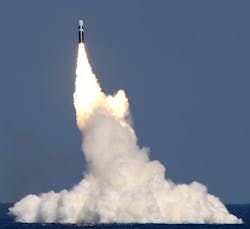Navy asks Draper Lab to update computers and navigation in submarine-launched nuclear missiles
WASHINGTON, 28 April 2014. U.S. Navy ballistic missile experts are continuing a program to fine-tune the accuracy of the Navy's Trident II D5 submarine-launched nuclear missiles under terms of a $283.1 million contract announced Friday to the Charles Stark Draper Laboratory Inc. in Cambridge, Mass.
Officials of the Navy Strategic Systems Program office in Washington are asking Draper Lab to handle failure verification, test, repair, and recertification of the Trident missile's inertial measurement units (IMUs), electronics assemblies, and electronic modules as part of the Trident missile's MK 6 guidance system repair program.
The Trident II is the primary weapon aboard Navy Ohio-class ballistic missile submarines. The missile has a range of more than 7,000 miles and carries four independently targeted 475-kiloton nuclear warheads.
The Trident missile's MK 6 guidance system consists of an electronics assembly with the system's flight computers, and an IMU with the system's inertial sensors. The electronics assembly interfaces with the submarine's fire-control system and the missile's flight-control electronics assembly. The IMU, meanwhile, senses the motion of missile and provides navigation information to the mission computer.
Related: Nuclear ballistic missile command and control technology still a prime military concern
Trident missiles are carried by 14 Navy Ohio-class submarines and four British Royal Navy Vanguard-class submarines. Each Ohio-class submarine can carry as many as 24 Trident atomic missiles. These vessels together carry about half of all U.S. strategic thermonuclear warheads.
The Draper Lab contract is part of a Navy effort begun in 2002 to extend the life of the D5 missiles to the year 2040 by replacing obsolete components with commercial off-the-shelf (COTS) hardware. Upgrades involved the missile reentry systems and guidance systems.
The first flight test of a D5 extended-life subsystem, the MK 6 Mod 1 guidance system, was in early 2012 aboard the Ohio-class ballistic missile submarine USS Tennessee (SSBN 734).
Related: Nuclear ballistic missile technology remains a post-Cold-War defense priority
The missile has a maximum speed of 13,000 miles per hour, and has precision guidance from inertial sensors with star sighting. No GPS-guided Trident D5 missiles have been deployed.
The Trident II missile warhead discharges the energy of 475,000 tons of TNT, and is roughly 30 times the size of the U.S. nuclear bomb dropped on Hiroshima, Japan, in 1945.
On this contract Draper Lab will do the work in Pittsfield, Mass.; Minneapolis; Clearwater, Fla.; Cambridge, Mass.; and Terrytown, N.Y., and should be finished by April 2017.
For more information contact Draper Lab online at www.draper.com, Aero Thermo Technology at www.aerothermo.com, or the Navy Strategic Systems Programs Office at www.ssp.navy.mil.

